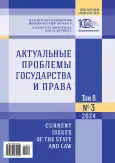On the issue of criminal professionalism development in the activities of fraudsters in pre-revolutionary Russia
- Authors: ZARUBINA K.A.1
-
Affiliations:
- Southwest State University
- Issue: Vol 8, No 3 (2024)
- Pages: 349-356
- Section: General Theory and History of Law and the State
- URL: https://journal-vniispk.ru/2587-9340/article/view/303237
- ID: 303237
Cite item
Full Text
Abstract
By the beginning of the 20th century, a cohesive and monolithic “caste” of professional criminals had formed in Russia. Their activities were distinguished by their particular danger, stability in time and space, as well as constancy, uncontrollability of development, diversity of forms of criminal “trades” and a high degree of protection from social and legal control. The aim of the study is to analyze the problem of the development of criminal professionalism in the activities of pre-revolutionary fraudsters in Russia. It is determined that the emergence of domestic professional fraud occurred in the 18th century. During this period, the legal structure of the basic elements of fraud, close to the modern concept, was first formally established in Russian legislation, and certain characteristic features of committing fraudulent acts on a professional basis were discovered in the activities of well-known professional criminals. It is proven that the final criminal community of professional swindlers was formed in Russia in the 19th – early 20th century. At this time, the main signs of criminal professionalism were revealed in the activities of fraudsters. By the beginning of the 20th century, professional fraudsters occupy an “honorable” place in the criminal hierarchy, acquire narrow specializations and the corresponding qualifications necessary to commit crimes and ensure their own safety, invulnerability from criminal prosecution, and also significantly strengthen their connections in the criminal world, including actively supporting and increasing the values of the criminal subculture.
About the authors
Kristina A. ZARUBINA
Southwest State University
Author for correspondence.
Email: kris1996z@mail.ru
ORCID iD: 0000-0003-2725-6906
Lecturer of Theory and History of State and Law Department
Russian Federation, 94 50 let Oktyabrya St., Kursk, 305003, Russian FederationReferences
- Foinitskii I.Ya. (1871). Moshennichestvo po russkomu pravu [Fraud under Russian Law]. Moscow, Ripol Klassik Publ., 289 p. (In Russ.)
- Kalyuzhnaya A.P. (2009). The evolution of norms providing for liability for fraud. Izvestiya vuzov. Severo-Kavkazskii region. Seriya: Obshchestvennye nauki = Bulletin of Hgher Education Institutes. Northern-Caucasus Region. Social Sciences, no. 6, pp. 104-107. (In Russ.) https://elibrary.ru/kzsioj
- Vladimirskii-Budanov M.F. (1887). Khrestomatiya po istorii russkogo prava: v 3 t. [Anthology on the History of Russian Law: in 3 vols.]. Kiev, vol. 2, 236 p. (In Russ.)
- Ershov V.V., Syrykh V.M. (2017). Istoriya suda i pravosudiya v Rossii: v 9 t. [History of the Court and Justice in Russia: in 9 vols.]. Moscow, Norma Publ., vol. 1, 688 p. (In Russ.)
- Matvienko A.E. (2021). Istoriya ugolovnogo rozyska [History of Criminal Investigation]. Moscow, Eksmo Publ., 240 p. (In Russ.)
- Dal’ V.I. (1990). Uslovnyi yazyk peterburgskikh moshennikov, izvestnyi pod imenem muzyki ili baikovogo yazyka [The conventional language of St. Petersburg swindlers, known under the name of music or fable language]. Voprosy Jazykoznanija, no. 1, pp. 134-137. (In Russ.) https://elibrary.ru/sfsxzr
- Lebedev S.Ya. (1995). Traditsii, obychai i prestupnost’. Teoriya, metodologiya, opyt kriminologicheskogo analiza [Traditions, Customs and Crime. Theory, Methodology, Experience of Criminological Analysis]. Moscow, Mezhregional’nyi tsentr kommercheskoi bezopasnosti Publ., 167 p. (In Russ.) https://elibrary.ru/yvotyl
- Akel’ev E.V. (2007). Moskovskie moshenniki XVIII v.: klichki, yazyk i razvlecheniya [Moscow swindlers of the 18th century: nicknames, language and entertainment]. Zhivaya starina, no. 1, pp. 46-48. (In Russ.) https://elibrary.ru/jxkczz
- Akel’ev E.V. (2008). Moskovskie karmanniki: organizatsiya prestupnykh grupp v seredine XVIII v. [Moscow pickpockets: the organization of criminal groups in the mid-18th century]. Novyi istoricheskii vestnik = New Historical Bulletin, no. 1 (17), pp. 161-167. (In Russ.) https://elibrary.ru/kxzcgd
- Anuchin E.N. (1873). Issledovaniya o protsente soslannykh v Sibir’ v period 1827–1846 godov. Materialy dlya ugolovnoi statistiki Rossii [Research on the Percentage of People Exiled to Siberia in the Period 1827–1846. Materials for Criminal Statistics of Russia]. St. Petersburg, 508 p. (In Russ.)
- Eliseev S.A. (2006). Obshchie cherty imushchestvennykh prestuplenii v tsarskoi Rossii [Common features of property crimes in tsarist Russia]. Vestnik TGPU = Tomsk State Pedagogical University Bulletin, no. 11 (62), pp. 37-40. (In Russ.) https://elibrary.ru/judftd
- Bezverkhov A.G., Korostеlev V.S. (2013). Proekt Ugolovnogo ulozheniya Rossiiskoi imperii 1813 goda [The draft Criminal Code of the Russian Empire of 1813]. Samara, “Samara State University” Publ., 192 p. (In Russ.) https://elibrary.ru/ubcjxt
- Lokhvitskii A.V. (1867). Kurs russkogo ugolovnogo prava [Course of Russian Criminal Law]. St. Peterburg, Izdanie zhurnala Ministerstva yustitsii Publ., 671 p. (In Russ.)
- Gurov A.I. (1990). Professional’naya prestupnost’: Proshloe i sovremennost’ [Professional Crime: Past and Present]. Moscow, Yuridicheskaya Literatura Publ., 301 p. (In Russ.)
- Kalpinskaya O.E. (2010). Osobennosti vozniknoveniya i razvitiya organizovannoi prestupnosti v dorevolyutsionnoi Rossii [Peculiarities of the emergence and development of organized crime in pre-revolutionary Russia]. Yurisprudentsiya, vol. 20, no. 4, pp. 103-108. (In Russ.) https://elibrary.ru/necbkt
- Belogrits-Kotlyarevskii L.S. (1903). Uchebnik russkogo ugolovnogo prava. Obshchaya i osobennaya chasti [Textbook of Russian Criminal Law. General and Special Parts]. Kiev, South Russian Book Publ., 618 p. (In Russ.)
- Maksimov S.V. (1871). Sibir’ i katorga: v 3 ch. [Siberia and Hard Labor: in 3 pts]. St. Petersburg, A. Transhelya Typography, pt 2, 353 p. (In Russ.)
Supplementary files









